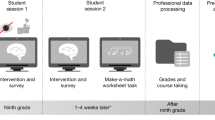Abstract
Objective:
The prevalence of adolescent obesity has increased considerably over the past decade in Switzerland and has become a serious public health problem in Europe. Prevention of obesity using various comprehensive programmes appears to be very promising, although we must admit that several interventions had generally disappointing results compared with the objectives and target initially fixed. Holistic programmes including nutritional education combined with promotion of physical activity and behaviour modification constitute the key factors in the prevention of childhood and adolescent obesity. The purpose of this programme was to incorporate nutrition/physical education as well as psychological aspects in selected secondary schools (9th grade, 14–17 years).
Methods:
The educational strategy was based on the development of a series of 13 practical workshops covering wide areas such as physical inactivity, body composition, sugar, energy density, invisible lipids, how to read food labels, is meal duration important? Do you eat with pleasure or not? Do you eat because you are hungry? Emotional eating. For teachers continuing education, a basic highly illustrated guide was developed as a companion booklet to the workshops. These materials were first validated by biology, physical education, dietician and psychologist teachers as well as school medical officers.
Results:
Teachers considered the practical educational materials innovative and useful, motivational and easy to understand. Up to now (early 2008), the programme has been implemented in 50 classes or more from schools originating from three areas in the French part of Switzerland. Based on the 1-week pedometer value assessed before and after the 1 school-year programme, an initial evaluation indicated that overall physical placidity was significantly decreased as evidenced by a significant rise in the number of steps per day.
Conclusion:
Future evaluation will provide more information on the effectiveness of the ADOS programme.
This is a preview of subscription content, access via your institution
Access options
Subscribe to this journal
Receive 12 print issues and online access
$259.00 per year
only $21.58 per issue
Buy this article
- Purchase on Springer Link
- Instant access to full article PDF
Prices may be subject to local taxes which are calculated during checkout



Similar content being viewed by others
References
http://www.iotf.org/ (accessed Dec 24, 2007).
Woringer V, Schutz Y . Obesity in Switzerland: body mass index (BMI) percentiles of a child and adolescent population born in 1980 in Lausanne and comparison with Swiss norms (1955). Soz Praventivmed 2003; 48: 121–132.
Lobstein T, Frelut ML . Prevalence of overweight among children in Europe. Obes Rev 2003; 4: 195–200.
Schutz Y, Woringer V . Obesity in Switzerland: a critical assessment of prevalence in children and adults. Int J Obes Relat Metab Disord 2002; 26 (Suppl 2): S3–S11. Review.
Suter PM, Schutz Y . Overweight and obesity in adults. 5th Nutrition Report, Dec 2004.
http://www.suissebalance.ch (accessed Dec 24, 2007).
Doak CM, Visscher TLS, Renders CM, Seidell JC . The prevention of overweight and obesity in children and adolescents: a review of interventions and programmes. Obes Rev 2006; 7: 111–136.
Story M . School-based approaches for preventing and treating obesity. Int J Obes Relat Metab Disord 1999; 23 (Suppl 2): S43–S51.
Lobstein T, Baur LA . Policies to prevent childhood obesity in the European Union. Eur J Public Health 2004; 5: 576–579.
http://www.villesante.com (access December 24, 2007). www.flvs.fr.
Heude B, Kettaneh A, Rakotovao R, Bresson JL, Borys JM, Ducimetière P, Charles MA . Anthropometric relationships between parents and children throughout childhood: the Fleurbaix-Laventie Ville Santé Study. Int J Obes (Lond) 2005; 29: 1222–1229.
www.eurobesitas.ch (accessed Dec 24, 2007).
Edwards B . Childhood obesity: a school-based approach to increase nutritional knowledge and activity levels. Nurs Clin North Am 2005; 40: 661–669.
Swinburn B, Egger G . Preventive strategies against weight gain and obesity. Obes Rev 2002; 3: 289–301.
Maffeis C, Pinelli L, Schutz Y . Fat intake and adiposity in 8 to 11-year-old obese children. Int J Obes Relat Metab Disord 1996; 20: 170–174.
Kumanyika S, Jeffery RW, Morabia A, Ritenbaugh C, Antipatis VJ . Public Health Approaches to the Prevention of Obesity (PHAPO), Working Group of the International Obesity Task Force (IOTF) Obesity prevention: the case for action. Int J Obes Relat Metab Disord 2002; 26: 425–436.
Stone EJ, McKenzie TL, Welk GJ, Booth ML . Effects of physical activity interventions in youth. Review and synthesis. Am J Prev Med 1998; 15: 298–315.
Tudor-Locke C, Bassett Jr DR . How many steps/day are enough? Preliminary pedometer indices for public health. Sports Med 2004; 34: 1–8.
Swinburn BA, Caterson I, Seidell JC, James WP . Diet, nutrition and the prevention of excess weight gain and obesity. Public Health Nutr 2004; 7: 123–146.
Acknowledgements
The development of practical guidelines and the basic teacher's guide were possible by the financial support of Suisse Balance. We are also indebted to Loterie Romande for financial support. We thank the directors of colleges and the vast number of teachers who have agreed to make rapid adaptations to their school programmes after inserting ‘ADOS’ in the basic teaching routine. We also thank Dr Souhail Latrèche, MD, for his helpful collaboration, his experience and his involvement.
Author information
Authors and Affiliations
Corresponding author
Additional information
Conflict of interest
The authors have declared no financial interests.
Rights and permissions
About this article
Cite this article
Durrer, D., Schutz, Y. ADOS: an educational primary prevention programme for preventing excess body weight in adolescents. Int J Obes 32 (Suppl 6), S72–S76 (2008). https://doi.org/10.1038/ijo.2008.209
Published:
Issue Date:
DOI: https://doi.org/10.1038/ijo.2008.209
Keywords
This article is cited by
-
Pushing forward to only ever healthy body weight in children and adolescents: the Swiss paradox
Mediterranean Journal of Nutrition and Metabolism (2012)
-
Comment aborder l’éducation thérapeutique d’un patient obèse ? La motivation du patient... et du médecin: une des clefs du succès thérapeutique ?
Obésité (2009)
-
Comment aborder l’éducation thérapeutique d’un patient obèse ? La motivation du patient… et du médecin: une des clefs du succès thérapeutique ?
Obésité (2009)



